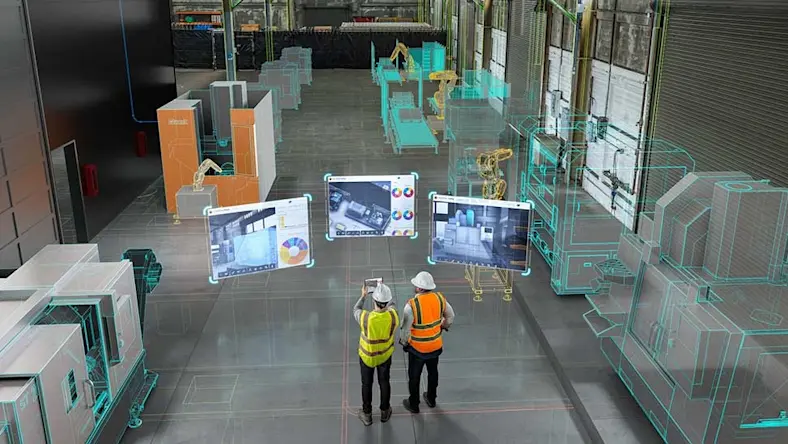& Construction

Integrated BIM tools, including Revit, AutoCAD, and Civil 3D
& Manufacturing

Professional CAD/CAM tools built on Inventor and AutoCAD
Digital technologies are transforming the nature of work, but no software and hardware can best the ingenuity found in the human brain. Businesses still depend on people, and ignoring the human factor in digital-transformation initiatives is a recipe for failure.
New research from IDC finds that more than 60% of enterprises admit they aren’t prepared to support the changing skill sets and working practices of their employees.
That’s complicating the global workforce shift that’s already underway, as technology advances and companies begin banking on tools such as artificial intelligence (AI) and extended reality to bring off-site expertise on-site and deliver more engineering and maintenance support remotely.
This kind of pivot is not likely to succeed if people aren’t central to planning. IDC says the most successful digital-transformation programs happen when organizations leverage digital technologies to ensure staff remains productive, engaged, and secure.
What does this look like in practice?
Employees can seamlessly access critical resources and collaborate effectively from any location, on any device, anytime, anywhere, with a consistently trouble-free experience. Factories and sites are smart, safe, secure, and sustainable.
Automation and augmentation (data analytics, AI, robotics) support employee tasks, processes, and decision-making.
Employees are released from simple and repetitive tasks, freeing them up to do more meaningful work.
Feeding a talent-development pipeline requires visibility into existing skills, profiles, and company needs, including paths for upskilling and reskilling.
Institutional knowledge that would otherwise be lost through retirement, loss of workers, or change in business focus is captured and replicated.
“AEC and manufacturing both need to adopt a people-first strategy to make their digital investments pay off,” says Giulia Carosella, IDC’s European digital transformation practice lead and principal analyst on the study. “That includes automating repeatable tasks and processes to free people’s time, enabling them to focus on high-value tasks and build new digital skills.”
As an example, Carosella cites Austrian industrial-design studio Edera Safety. In the early days of the pandemic, the firm’s product teams had to quickly shift to remote working. Leveraging cloud-based collaboration tools, they were able to design, prototype, and start manufacturing new products at record speed—some in just three months.
“Digital platforms helped them work more closely as a team, despite everyone operating off-site,” Carosella says. “They could collaborate with prototyping and production partners and get to market in record time. Before the sudden shift to digital working, it typically took Edera two years to take a product from concept to the market.”
Edera presents an impressive example, but every company is unique, and the pandemic’s lessons may take longer for some to actualize. Professor Iain Crosley, a director at manufacturing at software firm XpertRule, says companies have to look beyond technology for digital transformation to deliver sustained benefits.
“Digital transformation can’t be driven from the top down or the bottom up,” he says. “Everyone needs to buy in, from the C-suite level to people working on the shop floor. This is as much about upskilling and empowering employees as it is about driving new efficiencies for the company. Each individual needs to understand what’s in it for them.”
Crosley believes a lot of the challenge lies in communicating the benefits of this transformation. “I don’t think the technology is the real challenge,” he says. “You need to change the culture. To change the culture, people need to become more open to working in a collaborative environment to share ideas, experiences, data, and knowledge.
“A lot of people who drive digital initiatives come from the technology side, so they may be thinking that’s going to be the answer to everything. However, if people can’t accept it or can’t work with it or don’t have the skills to work with it, that’s where you get problems.”
As one of the first sectors to be released from COVID-19 lockdowns, AEC may have had a head start in terms of moving to a people-first orientation. This is especially important because, for years, the construction industry has faced a shortage of digital skills across traditional building trades and project-management practices.
At global engineering, design, and construction firm Mott MacDonald, expanding digital aptitudes has been firmly on the agenda for close to a decade. The company recently launched a digital literacy program for nearly 16,000 employees worldwide—the third iteration in more than nine years. It’s designed to build up digital skill sets in three areas: technology, commercial, and marketing—or as Digital Innovation Lead Jon Rains calls them, “the hackers, hustlers, and hipsters.”
“It’s easy to do the technical aspects, like coding, but that only covers about 30% of the people in the program,” Rains says. “What about the marketing people and the commercial people? We’ve got four parts to the program to ensure we’re all speaking the same language around digital and innovation. There’s a focused literacy module to ensure everyone understands critical concepts and how they apply to the business, an optimization module to make existing things better, a transformational module that is about doing completely new things, and an information-management module to clarify the value of the information we use and understand how data flows through the business.”
Mott Macdonald also has a separate program for 200 leaders across the business to define the challenges digital needs to solve, define methodologies for innovation, and identify the appropriate resources to move forward. “That’s all about people,” Rains says.
“The gap between strategy and results is people,” says Kathie Sorensen, author of Culture Eats Strategy for Lunch. “Regardless of what strategic path you take, it executes through people.”
IDC’s Carosella says leaders should take the following steps to assess the people-digital gap in their organizations:
Investigate the degree of automation and augmentation supporting employee teams. Is it optimal? Are there inefficiencies that can be eliminated?
Target reskilling. Automation enables employees to focus on value-added tasks and activities, increasing their personal satisfaction and benefiting the organization. Be prepared to support this transition.
Start improving employee engagement by gathering feedback and responding to changing employee needs.
“There's a corollary with process design,” Rains says. “When you start to optimize a process, you write down the steps involved and then look at how you could automate it. The truth is, not everything should be left to machines—in fact, you shouldn't really be aiming for more than 30%. More than that, and you take the human judgment out of it.
“You need to carefully choose a digital path based on the well-being of the people involved,” he continues. “And that’s a hard decision. It’s not an incremental build-upon, like mathematics. This is ‘back off five steps, step to the right, a few steps forward and then go.’ Completely new mindsets are required.”
Mark de Wolf is a freelance journalist and award-winning copywriter specializing in technology stories. Born in Toronto. Made in London. Based in Zürich. Reach him at markdewolf.com.
Executive insights
Executive insights
Executive insights






